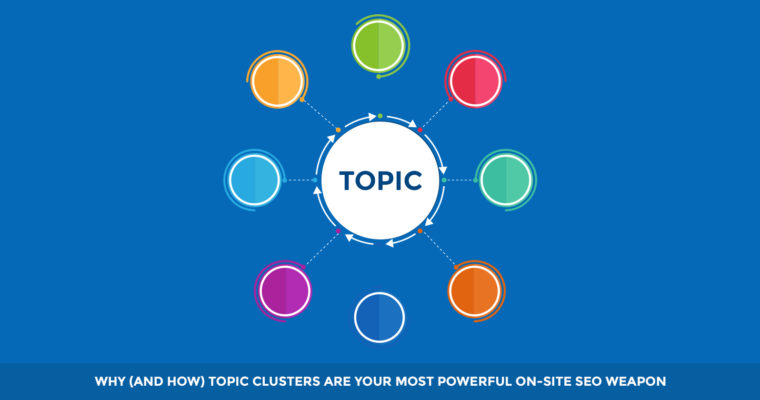 ‘ );
‘ );
h3_html = ‘
‘+cat_head_params.sponsor.headline+’
‘;
cta = ‘‘+cat_head_params.cta_text.text+’→‘
atext = ‘
‘+cat_head_params.sponsor_text+’
‘;
scdetails = scheader.getElementsByClassName( ‘scdetails’ );
sappendHtml( scdetails[0], h3_html );
sappendHtml( scdetails[0], atext );
sappendHtml( scdetails[0], cta );
// logo
sappendHtml( scheader, ” );
sc_logo = scheader.getElementsByClassName( ‘sc-logo’ );
logo_html = ”;
sappendHtml( sc_logo[0], logo_html );
sappendHtml( scheader, ” );
if(“undefined”!=typeof __gaTracker){
__gaTracker(‘create’, ‘UA-1465708-12’, ‘auto’, ‘tkTracker’);
__gaTracker(‘tkTracker.set’, ‘dimension1’, window.location.href );
__gaTracker(‘tkTracker.set’, ‘dimension2’, ‘seo’ );
__gaTracker(‘tkTracker.set’, ‘contentGroup1’, ‘seo’ );
__gaTracker(‘tkTracker.send’, { ‘hitType’: ‘pageview’, ‘page’: cat_head_params.logo_url, ‘title’: cat_head_params.sponsor.headline, ‘sessionControl’: ‘start’ });
slinks = scheader.getElementsByTagName( “a” );
sadd_event( slinks, ‘click’, spons_track );
}
} // endif cat_head_params.sponsor_logo
Topic clusters have been a popular trend in blogging and SEO for a few years now. While many have heard of this tactic, few have nailed it.
If executed properly, topic clusters can be the catalyst that launches your website to the top of the search engine results pages.
Well, maybe “launched” isn’t the right word; implementing a sound topic clustering strategy is a long, tedious process full of potential speed bumps.
At best, proper use of topic clusters can set you on a slow (but consistent) path to improving your search rankings and organic traffic.
Defining Topic Clusters
First of all, what exactly are topic clusters?
Basically, topic clusters are a multitude of content pieces that live on your website and are all linked to a common, overarching subject (known as pillar content).
As a single unit, all your topic clusters work to provide comprehensive insight on the pillar content.
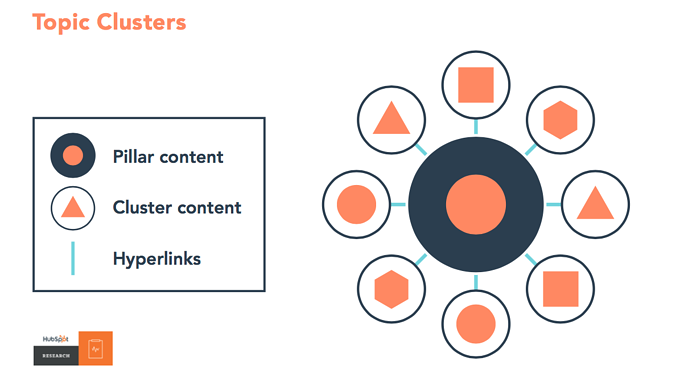
Pillar content is generally focused around a broad keyword with a high search volume, whereas topic clusters are focused on more specific keywords with smaller (attainable) search volumes.
For example, let’s say you are a digital agency that focuses on social media marketing/management. One of your pillar content pieces could be focused on the keyword “Facebook Marketing” (27,100/month).
Under the umbrella of this long-form piece, you could have topic clusters around keywords like:
- Facebook marketing for small business (590/month)
- Creating Facebook Ads (280/month)
- How to evaluate Facebook Ads (10/month)
These pieces would then be hyperlinked back to the pillar content.
The SEO goal of topic clusters is to gain search traffic for highly focused keywords and phrases with smaller search volumes. Ideally, the better rankings you can grab for clusters, the more credibility you build up in Google for the pillar content.
How Pillar Content Helps Google Understand Your Site
Pillar content works to lay the foundation for how you present your website to both users and the search engines.
When both humans and bots see your website, these pillars need to make it overtly clear what your site is all about and the value it offers.
Let’s look at HubSpot’s website.
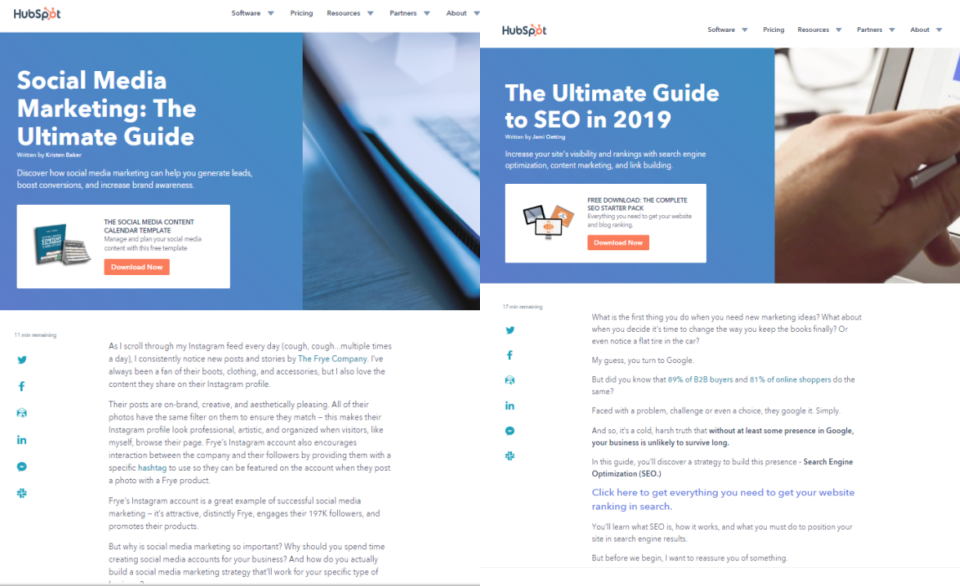
Above are two pieces of pillar content on social media and SEO. If you dive into these posts, you’ll notice they are packed with internal links to more specific pieces of content that fall under the respective social media and SEO umbrellas.
Your ultimate dream with pillar content is to someday earn decent rankings for the super general industry keywords.
The pillar content should be a long, exhaustive piece on the main subject. While this works to show Google and users what your site is about, the supporting topic clusters show them that you know the subject through-and-through.
Once you create pillar content, don’t just let it sit there and age.
As frequently as you can, do your best to add fresh data, tips, examples, and expert quotes to make sure it stays relevant. These elements will help it keep ranking on Google searches.
Specific Keyword Volumes Define Clusters
So how do you go about creating your topic clusters?
We mentioned earlier that you should aim to create these pieces of content around granular subtopics with low search volume keywords.
But where exactly do you start?
Well, we’ve heard the basic SEO tip to “go for the low-hanging fruit” keywords.
Ideally, the keywords you define your topic clusters around should work in a linear progression to gain rankings.
If you’re just starting out with this model, you are wise to plan out a topic hierarchy to funnel into the pillar content.
Developing a Topic Hierarchy
When I talk about using topic clusters as a long-term strategy to gain search rankings for broad, overarching keywords, I like to frame it like playing with dominoes. Each domino represents the search volume of a certain keyword.
The first domino is the smallest. Once you give it a nudge (meaning the content starts to gain search rankings), it should ideally knock down a slightly bigger domino, which will then knock down a bigger one, then a bigger one, and so on and so forth.
Let’s say you run a pay-per-click website.
One of your pieces of pillar content is focused on the broad keyword “Amazon advertising”.
Using the Keywords Everywhere extension, let’s see what kinds of related keywords and phrases we’re looking at for this term:
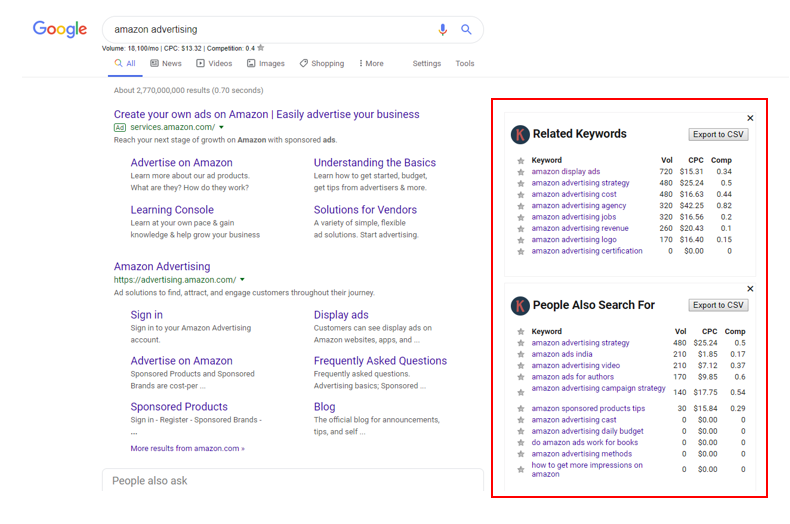
You’ll see that there are definitely some terms we can target for more granular clusters, however, there isn’t a whole lot to choose from.
Let’s click on the top related keyword “Amazon display ads” and see what comes up.
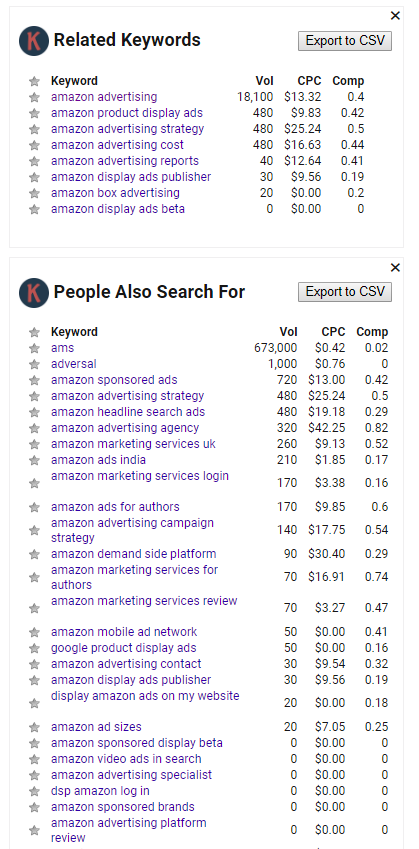
Now, we’ve got a little bit more to work with.
If you’re just getting your content strategy up and running, you are wise to build your clusters from the ground up with topics/keywords like:
- Amazon Ad Sizes: How to Create Your Marketing Plan Accordingly (20/month)
- How Can I Display Amazon Ads on My Website? (20/month)
As you start to gain rankings for these keywords (or knock down the first domino), your next post can target keywords with larger search volumes with topic clusters like:
- How Does the Amazon Mobile Ad Network Function? (50/month)
Once you see rankings for this term, your next topic cluster could be:
- How to Lay Out an Amazon Advertising Campaign Strategy (140/month)
- Tips for Creating Amazon Product Display Ads (480/month)
So, in this scenario, your topic hierarchy might look something like this:
- Tips for Creating Amazon Product Display Ads (480/month)
– How to Lay Out an Amazon Advertising Campaign Strategy (140/month)
– How Does the Amazon Mobile Ad Network Function? (50/month)
– How Can I Display Amazon Ads on My Website? (20/month)
The topic hierarchy should be governed by relevant search volumes and how well it can be tied back to the pillar content.
Once you gain rankings for these particular search terms, it means that Google sees your website as an expert source of information on the topic. Therefore, it is likely to do the same with related terms and phrases with higher search volumes.
The idea is that you gradually start creating content around larger and larger keywords, then ultimately, you start ranking for those overarching terms in your pillar content.
Understand the User Intent Behind Topic Clusters
When you create any sort of content, the golden rule has always been (and always will be) to make it all about the user.
This tidbit of wisdom is something that pretty much every marketer knows by now, however, it’s relatively easy to miss the mark.
The main objective is to bridge the gap between what the person enters into Google and how you can bring them to their end goal.
So, as you dive into your topic clustering strategy, you need to have a firm knowledge related to the types of questions people are asking.
To use the pay-per-click example again, let’s see what questions people are asking about this general topic using the Ahrefs Questions feature.
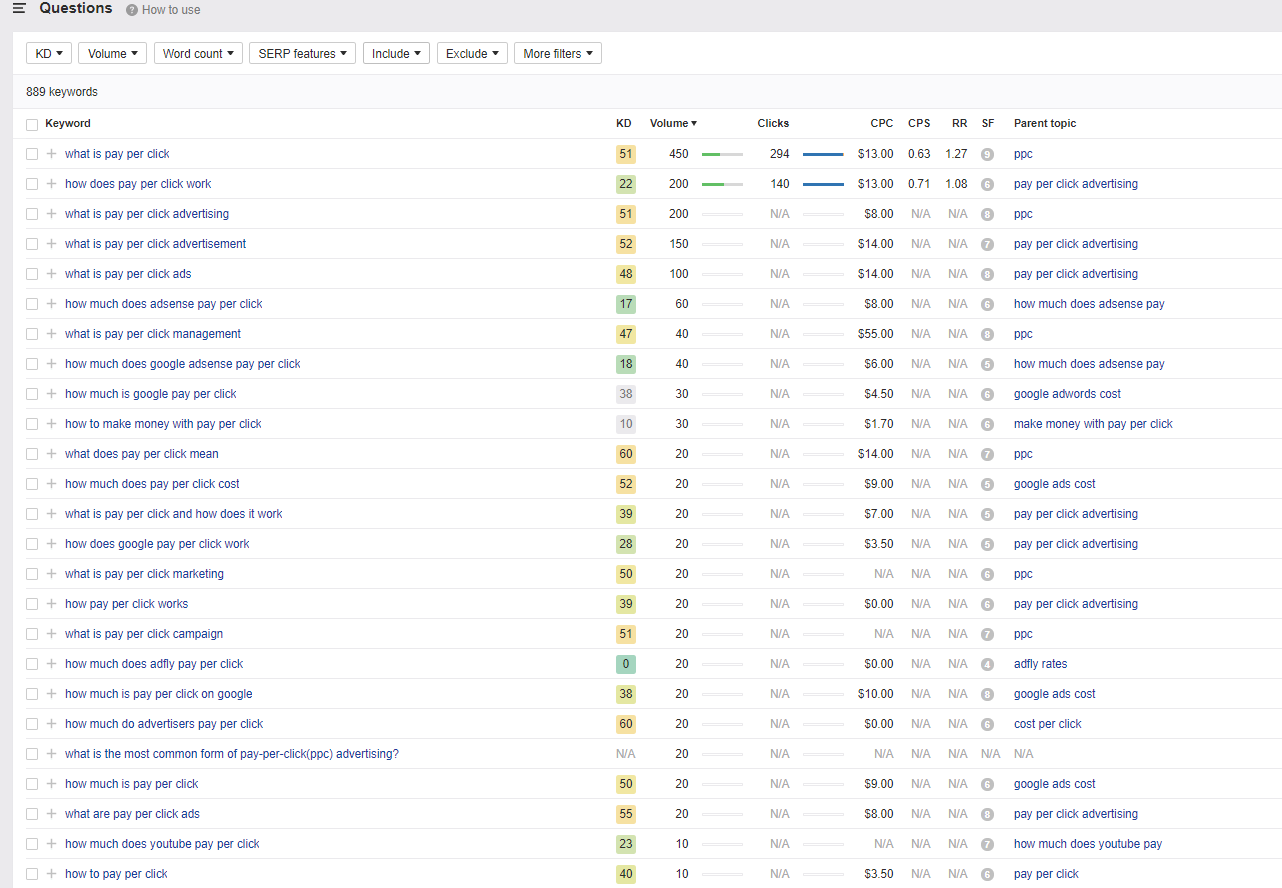
Given these findings, the topic clusters you create could work to answer questions like:
- How much does AdSense Pay Per Click cost?
- How much does YouTube Pay Per Click cost?
- What is Pay Per Click management?
And so on.
The term “user intent” is perhaps the biggest buzzword in SEO today. The better you are at getting to the root of it with your content, the more love it should get from Google!
The Value of Interlinking
The importance of sound interlinking cannot be understated.
Your internal linking structure helps Google understand:
- The relationship between the pages.
- The value of the pages.
- The relevance of the pages.
The big purpose of using topic clusters is to give the search engines a good understanding of your website. As you interlink your topic clusters, it should all feed into your expertise of the pillar content.
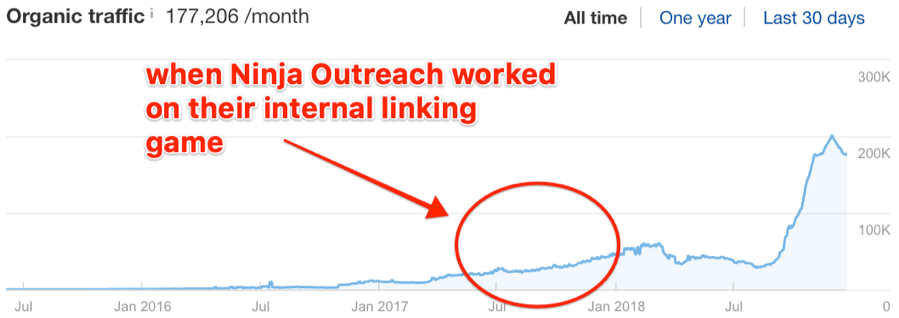
While there may be some exceptions, in the realm of topic clusters, you are wise to keep the bulk of your interlinking under the same pillar content.

This will work to establish your site structure and effectively spread link equity.
The Wrap
The topic cluster framework is a big one. Ideally, it’s one that never ends.
If planned properly, the unification of your topic clusters can be your most powerful SEO weapon in gaining industry authority, as well as rankings for those general keywords with massive search volumes.
The most important mindset to have about topic clusters is that each and every piece of content you create works as a vector to solidify your expertise on the pillar content.
While there are no guarantees that topic clusters will give you Page 1 rankings, it’s a long-term step in the right direction.
Image Credits
Featured Image: Created by author, July 2019
In-Post Image #1: HubSpot
In-Post Image #2-5: Screenshots taken by author, July 2019
In-Post Image #6: Ahrefs
In-Post Image #7: Moz
